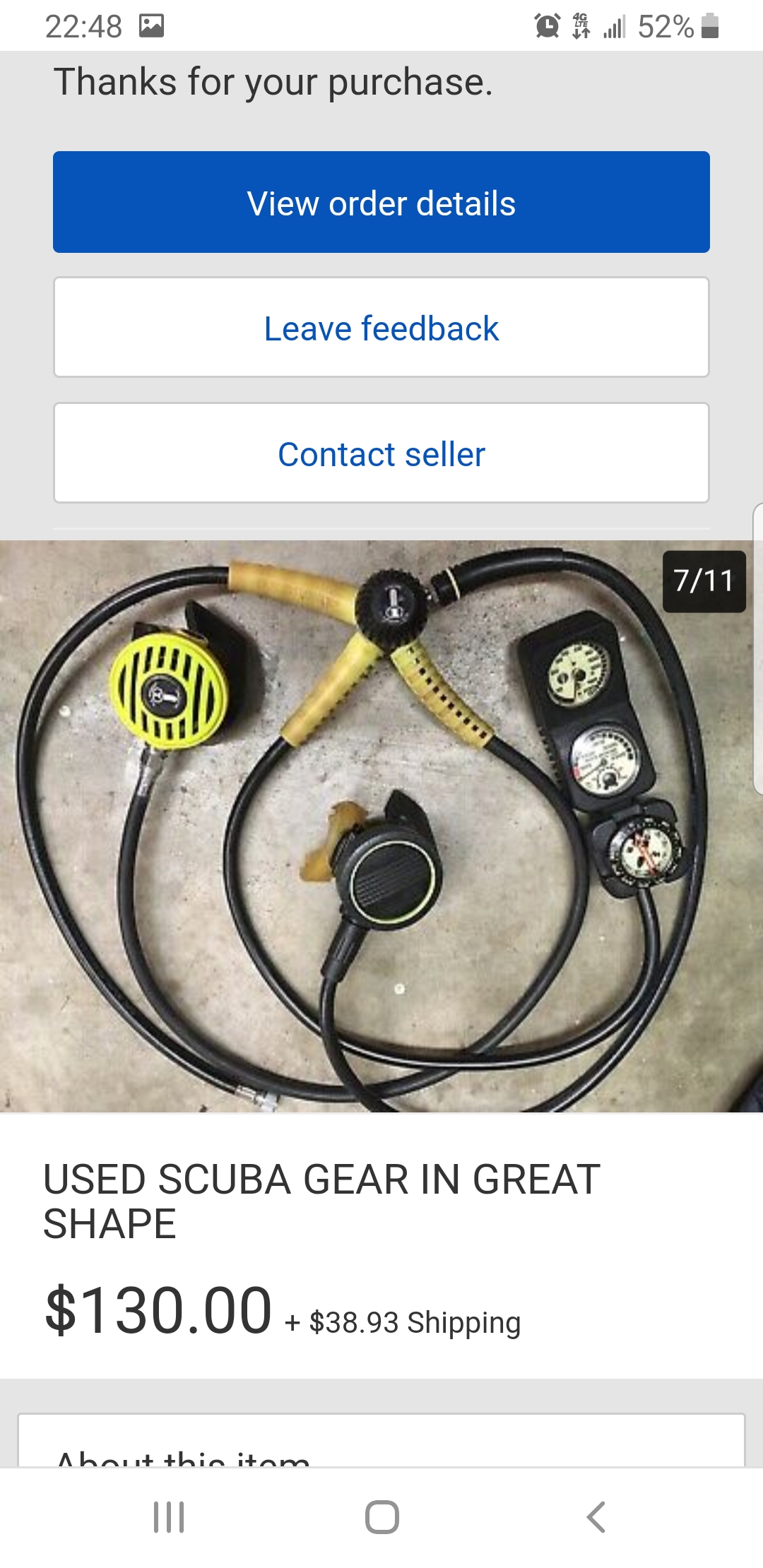You are using an out of date browser. It may not display this or other websites correctly.
You should upgrade or use an alternative browser.
You should upgrade or use an alternative browser.
Hiya Everybody!
- Thread starter reep39
- Start date
Please register or login
Welcome to ScubaBoard, the world's largest scuba diving community. Registration is not required to read the forums, but we encourage you to join. Joining has its benefits and enables you to participate in the discussions.
Benefits of registering include
- Ability to post and comment on topics and discussions.
- A Free photo gallery to share your dive photos with the world.
- You can make this box go away
Hi, Tom!
Welcome to ScubaBoard! You'll find lots of folks willing to lend their expertise.
Re: your request, we'll need a couple of side and end photos of the first stage.
The handle looks to be a Conshelf, though I can't tell without a side view. One second stage is a standard Aqualung downstream. The octo might be a Genesis, but again, it's too difficult to tell.
w
With a few pics, I'm sure folks can ID your new regs and give you suggestions on service.
Again, welcome to the forums!
Welcome to ScubaBoard! You'll find lots of folks willing to lend their expertise.
Re: your request, we'll need a couple of side and end photos of the first stage.
The handle looks to be a Conshelf, though I can't tell without a side view. One second stage is a standard Aqualung downstream. The octo might be a Genesis, but again, it's too difficult to tell.
w
With a few pics, I'm sure folks can ID your new regs and give you suggestions on service.
Again, welcome to the forums!
reep39
Registered
Thanks! I do t have them yet. Pocked up a gear set off ebay: regs, console, bcd, and some extras for $150. Dont have thw gear yet. had it shipped to my parents to get service done as there is no service tech at the local dive shop where I am. Hope to have it all in a couple weeks.Hi, Tom!
Welcome to ScubaBoard! You'll find lots of folks willing to lend their expertise.
Re: your request, we'll need a couple of side and end photos of the first stage.
The handle looks to be a Conshelf, though I can't tell without a side view. One second stage is a standard Aqualung downstream. The octo might be a Genesis, but again, it's too difficult to tell.
With a few pics, I'm sure folks can ID your new regs and give you suggestions on service.
Again, welcome to the forums!
reep39
Registered
Aqualung Downstream?Hi, Tom!
Welcome to ScubaBoard! You'll find lots of folks willing to lend their expertise.
Re: your request, we'll need a couple of side and end photos of the first stage.
The handle looks to be a Conshelf, though I can't tell without a side view. One second stage is a standard Aqualung downstream. The octo might be a Genesis, but again, it's too difficult to tell.
With a few pics, I'm sure folks can ID your one regs and give you suggestions in service.
Again, welcome to the forums!
We all start somewhere.
With all that ScubaBoard has to offer, you'll be tweaking your rig for the next 20 years, lol!
Welcome to the club!
With all that ScubaBoard has to offer, you'll be tweaking your rig for the next 20 years, lol!
Welcome to the club!
Start here:Aqualung Downstream?
Diving regulator - Wikipedia
There is a paragraph midway in there that you can jump to directly from the table of contents, called "Downstream valve"
If you want to geek up about it, you can spend $80 from scubatools.com on "Regulator Savvy", the absolute Bible of how scuba regulators work.
But before you take the plunge, use the search function here on ScubaBoard for awhile. There's a gazillion threads on anything and everything scuba.
The short answer to your question is that a downstream valve is just a spring loaded cap on the tube that supplies the air. The greater the pressure under the cap, the easier it is to open. The lower the pressure under the cap, the more you have to oppose the spring to open the valve and suck air. Simple, foolproof, easy to build.
In the old days, the first stage would supply gas to the second stage at lower and lower pressures as the tank emptied. With a simple downstream second stage, it got harder and harder to breathe as the tank emptied. Since they didn't have gauges back then, they figured that was a good way to know when it was time to end the dive.
We're more sophisticated now, and some second stages are "balanced downstream valves." They use the tanks changing pressure to balance the effort of opening the valve, so things stay constant throughout the dive, and you can breathe your tank right down to the bitter end. Of course, that means that if you don't watch your gauges, you go out of air. Fix one problem...get a new one. But me, I'd rather be able to use my whole tank easily, especially if I'm using it to get to the surface after not paying attention to my gauges. In contrast, many divers prefer a plain downstream valve because it's simpler and maybe more reliable. They rely on a balanced FIRST stage to maintain the pressure the second stage needs.
As you can see, there's tons to learn about. Lots of folks here are happy to guide you down the garden path...
Or is it the Yellow Brick Road?
Similar threads
- Replies
- 1
- Views
- 328
- Replies
- 20
- Views
- 4,468





